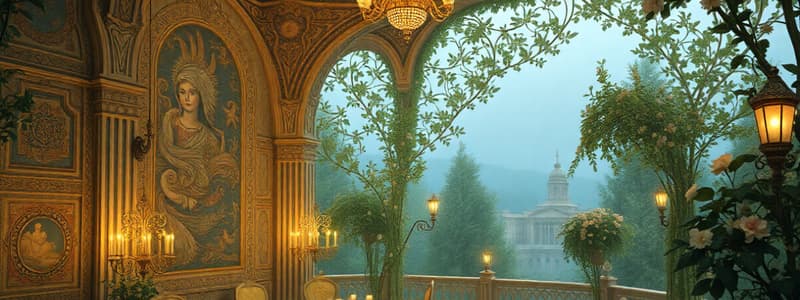Podcast
Questions and Answers
What was the prevailing assumption among European thinkers about non-European civilizations in the sixteenth century?
What was the prevailing assumption among European thinkers about non-European civilizations in the sixteenth century?
- They were thought to be culturally superior.
- They were viewed as equal to European cultures.
- They were seen as advanced and innovative.
- They were considered to be backward and primitive. (correct)
What theory emerged from the belief that civilization originated from a single location?
What theory emerged from the belief that civilization originated from a single location?
- The diffusionist theory. (correct)
- The cultural relativism theory.
- The multilinear evolution theory.
- The autonomous development theory.
Which ancient civilization did some European thinkers regard as the ultimate source of all civilization?
Which ancient civilization did some European thinkers regard as the ultimate source of all civilization?
- Mesoamerica
- Egypt (correct)
- Mesopotamia
- China
What evidence undermined the belief that ancient Egyptians spread civilization worldwide?
What evidence undermined the belief that ancient Egyptians spread civilization worldwide?
What misconception did European thinkers hold regarding ancient non-European monuments?
What misconception did European thinkers hold regarding ancient non-European monuments?
What is a significant feature of the archaeological evidence regarding the development of civilizations?
What is a significant feature of the archaeological evidence regarding the development of civilizations?
Which of the following best describes the construction and purpose of the terra-cotta army?
Which of the following best describes the construction and purpose of the terra-cotta army?
What unique aspect was ensured in the production of the terra-cotta warriors?
What unique aspect was ensured in the production of the terra-cotta warriors?
What can be concluded about the economic roles of agriculture in various civilizations?
What can be concluded about the economic roles of agriculture in various civilizations?
What does the grandeur of Ying Zheng's tomb illustrate about the societal values of the time?
What does the grandeur of Ying Zheng's tomb illustrate about the societal values of the time?
Flashcards
Diffusionist School of Anthropology
Diffusionist School of Anthropology
A theory proposing that civilization originated in one place and spread outwards.
European Conceit
European Conceit
The mistaken belief that Europeans were superior and that other cultures were primitive.
Ancient Egyptian Civilization
Ancient Egyptian Civilization
An ancient civilization that was believed to be the originator of other civilizations.
Archaeological Evidence
Archaeological Evidence
Signup and view all the flashcards
Multiple Civilizations
Multiple Civilizations
Signup and view all the flashcards
Independent Development of Civilization
Independent Development of Civilization
Signup and view all the flashcards
Terracotta Army
Terracotta Army
Signup and view all the flashcards
Qin Shi Huang
Qin Shi Huang
Signup and view all the flashcards
Conspicuous Consumption
Conspicuous Consumption
Signup and view all the flashcards
Mass Production (Terracotta)
Mass Production (Terracotta)
Signup and view all the flashcards
Study Notes
European Thinkers and Diffusionism
- Sixteenth-century European thinkers assumed non-European cultures were primitive and incapable of complex achievements.
- This led to the diffusionist school of anthropology.
- They believed civilization originated in one place and spread.
- Europeans were believed to be the inheritors of this civilization.
- This theory was inaccurate.
Archaeological Evidence and Multiple Civilizations
- Archaeological evidence shows independent development of civilizations in various regions.
- Examples include Pakistan, China, Mesoamerica, and South America.
- Attempts to attribute these to a single origin culture (e.g., Egypt) are not supported by evidence.
- Distinct and unique developmental sequences exist in various civilizations, with unique elements that are not explainable by single origins.
- Different civilizations developed different crops, animals and technologies.
- Structures like pyramids had differences in construction, function, and timeline, indicating independent development.
Qin Shihuang's Mausoleum and Terracotta Army
- Qin Shihuang, first emperor of a united China, was buried with a massive tomb and a terracotta army.
- The tomb was constructed over 38 years.
- The terracotta army includes thousands of life-sized warriors, generals, and horses.
- The figures were made of fire-baked ceramic (terracotta).
- The figurines exhibit detailed renditions of individual characteristics.
- Each soldier was unique with different facial expressions and uniform details.
- This intricate artistic army was a massive undertaking employing a workforce estimated at 700,000.
- The soldiers were painted, giving the army a lifelike appearance.
Studying That Suits You
Use AI to generate personalized quizzes and flashcards to suit your learning preferences.
Description
Explore the ideas of sixteenth-century European thinkers regarding non-European cultures and the diffusionist perspective in anthropology. This quiz discusses the inaccuracies of the belief that civilization originated in one place and provides archaeological evidence for the independent development of civilizations across the globe.




